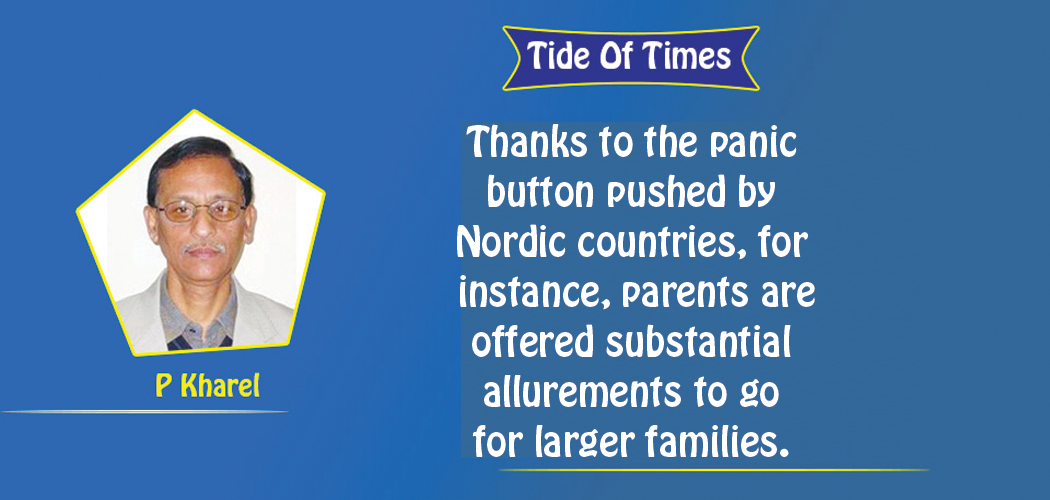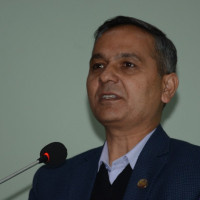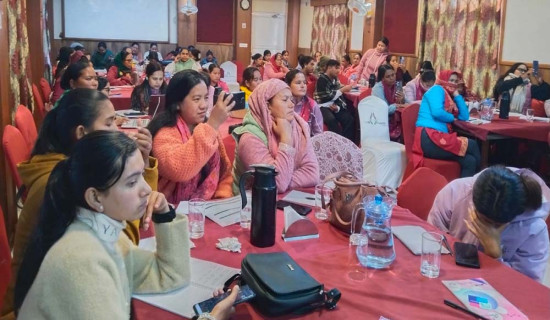- Wednesday, 24 December 2025
Politics Of Demographics
P Kharel
There comes a time when population growth flattens and peters off to take a downward turn. Governments in industrially advanced nations as well as elsewhere were aware of this fact decades ago, thanks to demography experts who kept them abreast of what would be round the corner. Today, fear of the fast fall in fertility rate grips many a nation. Among them are the three superpowers: China, the United States and Russia. Population is shrinking in these countries as well as in most of Europe, Japan, South Korea and Singapore, among scores of others.
Earlier, the cycle of poverty was attributed to high fertility rate. In Nepal, motherhood against the background of pregnancies occurring too early, too frequently and too late were treated as issues of grave concern. Family planning strategies were developed accordingly. Back in the 1970s and the 1980s, the press regularly carried extensive in-depth reports on the gradual shrinking of family size that would eventually lead to individuals without any sibling, uncle or aunt at the height of one-child family.
Some sections tried dismissing such data as coming from prophets of doom and gloom without adherence to the balancing process nature would bestow. Preference for male child dominated many societies. I recall a particular poster plastered all over the place in a Bangladeshi province Comilla city, during a visit to rickshaw pullers’ union representing hundreds of thousands of members: Son or daughter, two is ideal. The aim was to ultimately attain replacement level.
The thrust of one-child family begins from urban centres, spreading to the suburbs and eventually creeping into the rural areas. China was ridiculed when it launched a one-child policy at a time when Western aid agencies and INGOs advocated two-child families in developing countries even if reluctant to introduce such campaigns in oil-rich Arab capitals in West Asia and its neighbourhood.
Call for reversal
There used to be times when demographers narrated how long it would take for a nation’s population to double. These days the focus has shifted to discussion on how long it takes for the population of octogenarians in a given country to double. Better health services and other welfare measures have contributed to higher longevity.
The Vatican’s Pope Francis not long ago regretted “selfish” couples showing preference to pets instead of children who could otherwise address the onset of “demographic winter” the West was experiencing. In fact, not just the West but much of the world faces a steady drop in fertility growth rate. Had the pope gone a step further in his criticism, “pro-choice” champions might have stood up in arms.
The question is one of convincing people to have more babies after decades of efforts at “population control”. The economic benefits of a small family that would enable people to break the vicious cycle of woes pertaining to basic needs — food, education, health, shelter and steady income — were extensively highlighted and encouraged by top echelons of elite and governments together with non-government agencies with gay abandon. With the fast fall in fertility rates, the aging population, disproportionate to the presence of youth population, is the consequence. That was coming in Europe since trend emerged in the 1970s. The challenge now is how to reverse the situation.
China, the world’s most-populous state, with a population projected to peak at near 1.45 billion by 2030, faces a drastic decline by the end of this century. Within the next seven decades, its population is expected to significantly fall below the 700 million mark. The pressure on the communist government is obvious. The United States, too, is heading for a big slump in population growth. For that matter, such conditions already stare at most developed countries while quite a few developing states are racing toward similar crises.
Once a certain pattern in the demography is recorded, a thick sticky web of complications emerges. It takes long, painstaking and elaborate efforts to stem a worrisome trend and gradually reverse the process for balanced growth. Previously indifferent governments are now desperate to turn the tide for the better by dangling incentives at parents to have more babies and ensure that labour supply does not shrink.
Thanks to the panic button pushed by Nordic countries, for instance, parents are offered substantial allurements to go for larger families. South Korea alone has given extra incentives to the tune of well over $130 billion but not yet with the desired outcome. In short, the panic button is on all over the world with a population of 8 billion this year. The exception, right now, is the African continent, which is headed to account for more than two billion people, i.e., a quarter of the global population. More than half of the continent’s 54 nations will register their present populations doubled by 2050.
Big role change
Well within a decade, demographers expect India to overtake China as the most-populous country at slightly over 1.45 billion. Thereafter, the process of stagnation, followed by a sharp shrink in the hike, will be on a steady march in India. Why don’t the countries recording gravely low fertility rate plunge into the ready opportunity to rely on ever keen migrant workers from elsewhere?
Communal considerations, parochial interests under the guise of national welfare and core rightwing tendencies prevent them from taking a humanitarian approach. Had they not faced such problems, their governments and labour experts would have been forthright in prescribing migrant workers for states in labour supply.
If and when policies accepting large scale migrant workers get introduced, the governments concerned will engage in taking great care for ensuring that the dominant class would not be overwhelmed by the legitimate democratic rights of the migrants. Race and class structures play a big role in the related strategies. Hence diversity will be maximised not for declared principles but for preventing a particular group posing a threat to the traditionally dominant and powerful local groups.
After all, playing the preceptor has always been far easier than putting precepts into practice.
(Professor Kharel specialises in political communication.)

















